Smitha Milli
What's In My Human Feedback? Learning Interpretable Descriptions of Preference Data
Oct 30, 2025Abstract:Human feedback can alter language models in unpredictable and undesirable ways, as practitioners lack a clear understanding of what feedback data encodes. While prior work studies preferences over certain attributes (e.g., length or sycophancy), automatically extracting relevant features without pre-specifying hypotheses remains challenging. We introduce What's In My Human Feedback? (WIMHF), a method to explain feedback data using sparse autoencoders. WIMHF characterizes both (1) the preferences a dataset is capable of measuring and (2) the preferences that the annotators actually express. Across 7 datasets, WIMHF identifies a small number of human-interpretable features that account for the majority of the preference prediction signal achieved by black-box models. These features reveal a wide diversity in what humans prefer, and the role of dataset-level context: for example, users on Reddit prefer informality and jokes, while annotators in HH-RLHF and PRISM disprefer them. WIMHF also surfaces potentially unsafe preferences, such as that LMArena users tend to vote against refusals, often in favor of toxic content. The learned features enable effective data curation: re-labeling the harmful examples in Arena yields large safety gains (+37%) with no cost to general performance. They also allow fine-grained personalization: on the Community Alignment dataset, we learn annotator-specific weights over subjective features that improve preference prediction. WIMHF provides a human-centered analysis method for practitioners to better understand and use preference data.
CTRL-Rec: Controlling Recommender Systems With Natural Language
Oct 14, 2025

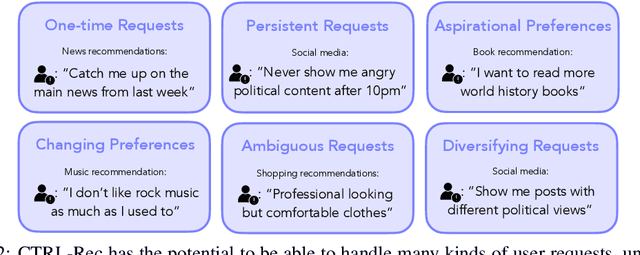

Abstract:When users are dissatisfied with recommendations from a recommender system, they often lack fine-grained controls for changing them. Large language models (LLMs) offer a solution by allowing users to guide their recommendations through natural language requests (e.g., "I want to see respectful posts with a different perspective than mine"). We propose a method, CTRL-Rec, that allows for natural language control of traditional recommender systems in real-time with computational efficiency. Specifically, at training time, we use an LLM to simulate whether users would approve of items based on their language requests, and we train embedding models that approximate such simulated judgments. We then integrate these user-request-based predictions into the standard weighting of signals that traditional recommender systems optimize. At deployment time, we require only a single LLM embedding computation per user request, allowing for real-time control of recommendations. In experiments with the MovieLens dataset, our method consistently allows for fine-grained control across a diversity of requests. In a study with 19 Letterboxd users, we find that CTRL-Rec was positively received by users and significantly enhanced users' sense of control and satisfaction with recommendations compared to traditional controls.
Choosing the Right Weights: Balancing Value, Strategy, and Noise in Recommender Systems
May 27, 2023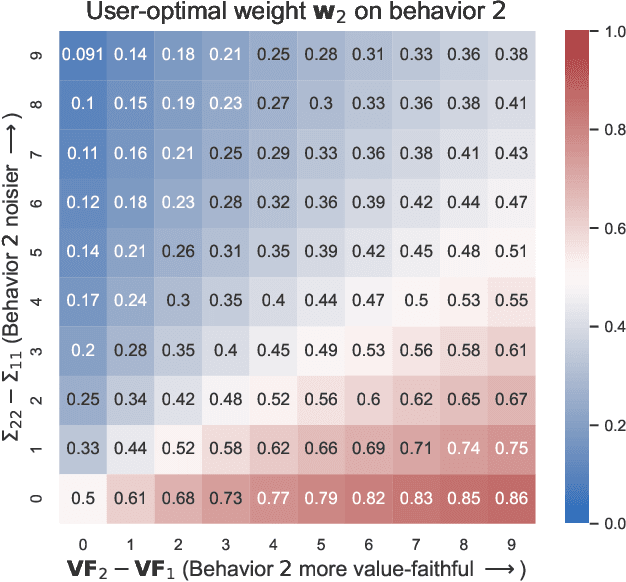

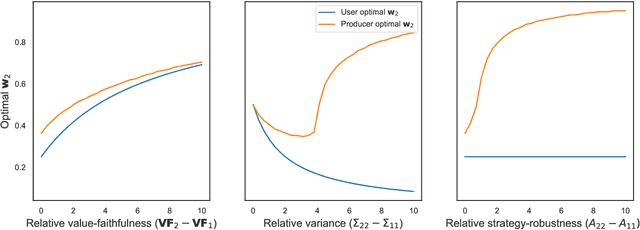

Abstract:Many recommender systems are based on optimizing a linear weighting of different user behaviors, such as clicks, likes, shares, etc. Though the choice of weights can have a significant impact, there is little formal study or guidance on how to choose them. We analyze the optimal choice of weights from the perspectives of both users and content producers who strategically respond to the weights. We consider three aspects of user behavior: value-faithfulness (how well a behavior indicates whether the user values the content), strategy-robustness (how hard it is for producers to manipulate the behavior), and noisiness (how much estimation error there is in predicting the behavior). Our theoretical results show that for users, upweighting more value-faithful and less noisy behaviors leads to higher utility, while for producers, upweighting more value-faithful and strategy-robust behaviors leads to higher welfare (and the impact of noise is non-monotonic). Finally, we discuss how our results can help system designers select weights in practice.
Causal Inference Struggles with Agency on Online Platforms
Jul 19, 2021
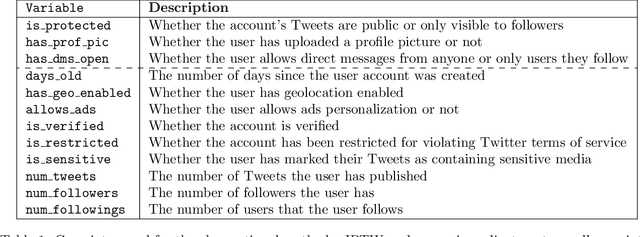

Abstract:Online platforms regularly conduct randomized experiments to understand how changes to the platform causally affect various outcomes of interest. However, experimentation on online platforms has been criticized for having, among other issues, a lack of meaningful oversight and user consent. As platforms give users greater agency, it becomes possible to conduct observational studies in which users self-select into the treatment of interest as an alternative to experiments in which the platform controls whether the user receives treatment or not. In this paper, we conduct four large-scale within-study comparisons on Twitter aimed at assessing the effectiveness of observational studies derived from user self-selection on online platforms. In a within-study comparison, treatment effects from an observational study are assessed based on how effectively they replicate results from a randomized experiment with the same target population. We test the naive difference in group means estimator, exact matching, regression adjustment, and inverse probability of treatment weighting while controlling for plausible confounding variables. In all cases, all observational estimates perform poorly at recovering the ground-truth estimate from the analogous randomized experiments. In all cases except one, the observational estimates have the opposite sign of the randomized estimate. Our results suggest that observational studies derived from user self-selection are a poor alternative to randomized experimentation on online platforms. In discussing our results, we postulate "Catch-22"s that suggest that the success of causal inference in these settings may be at odds with the original motivations for providing users with greater agency.
From Optimizing Engagement to Measuring Value
Aug 21, 2020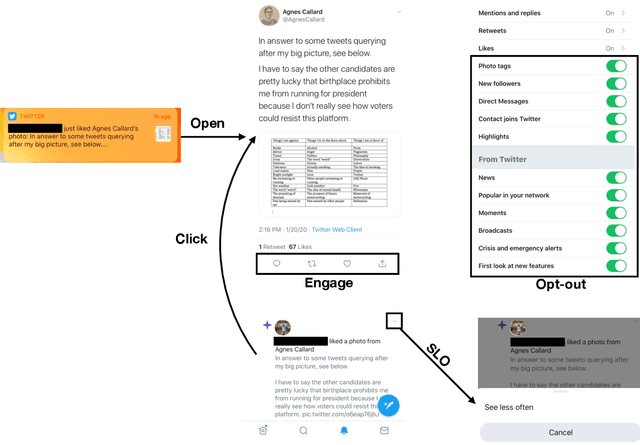
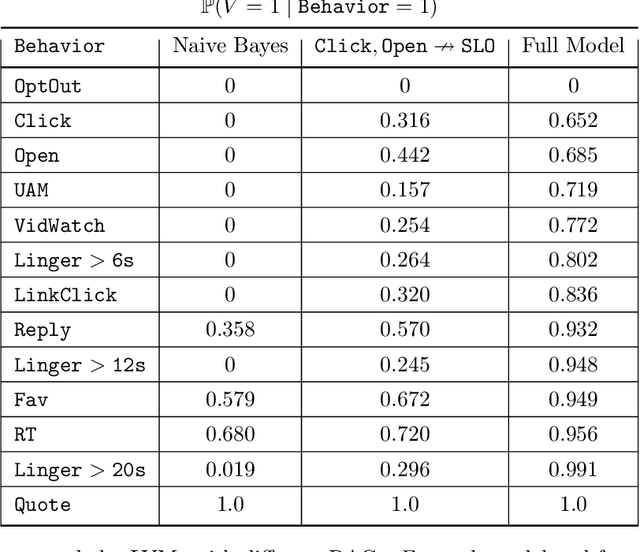
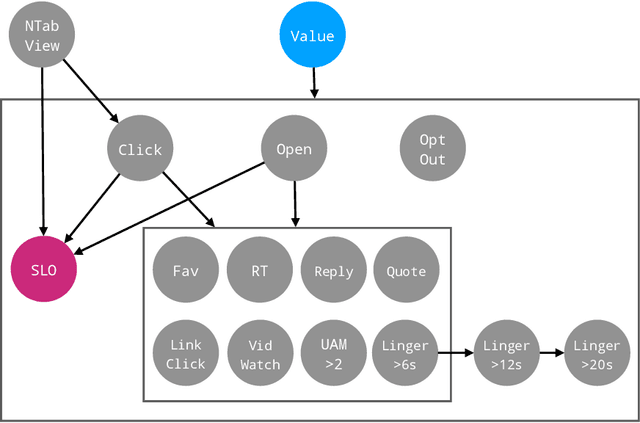
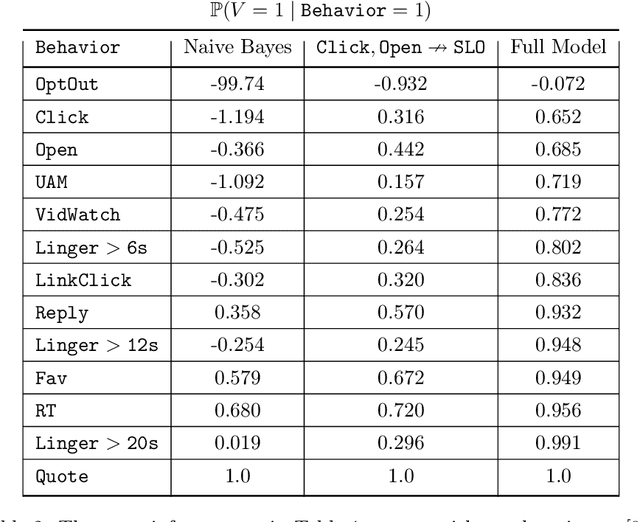
Abstract:Most recommendation engines today are based on predicting user engagement, e.g. predicting whether a user will click on an item or not. However, there is potentially a large gap between engagement signals and a desired notion of "value" that is worth optimizing for. We use the framework of measurement theory to (a) confront the designer with a normative question about what the designer values, (b) provide a general latent variable model approach that can be used to operationalize the target construct and directly optimize for it, and (c) guide the designer in evaluating and revising their operationalization. We implement our approach on the Twitter platform on millions of users. In line with established approaches to assessing the validity of measurements, we perform a qualitative evaluation of how well our model captures a desired notion of "value".
Reward-rational (implicit) choice: A unifying formalism for reward learning
Feb 12, 2020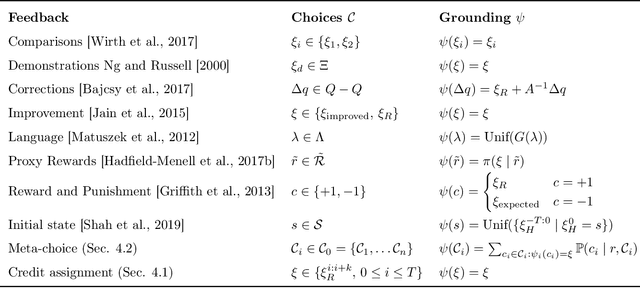
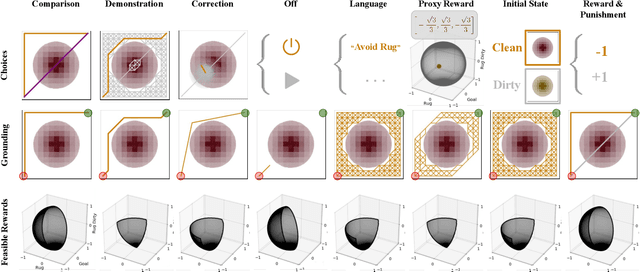
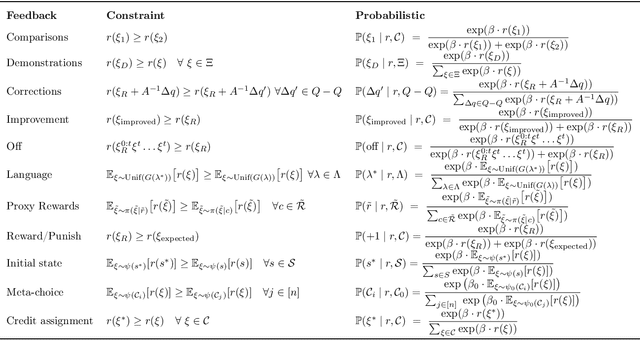
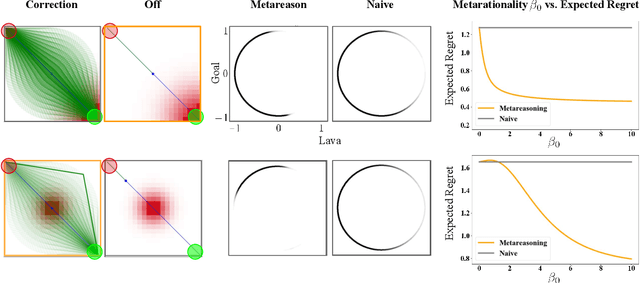
Abstract:It is often difficult to hand-specify what the correct reward function is for a task, so researchers have instead aimed to learn reward functions from human behavior or feedback. The types of behavior interpreted as evidence of the reward function have expanded greatly in recent years. We've gone from demonstrations, to comparisons, to reading into the information leaked when the human is pushing the robot away or turning it off. And surely, there is more to come. How will a robot make sense of all these diverse types of behavior? Our key insight is that different types of behavior can be interpreted in a single unifying formalism - as a reward-rational choice that the human is making, often implicitly. The formalism offers both a unifying lens with which to view past work, as well as a recipe for interpreting new sources of information that are yet to be uncovered. We provide two examples to showcase this: interpreting a new feedback type, and reading into how the choice of feedback itself leaks information about the reward.
Value-laden Disciplinary Shifts in Machine Learning
Dec 03, 2019
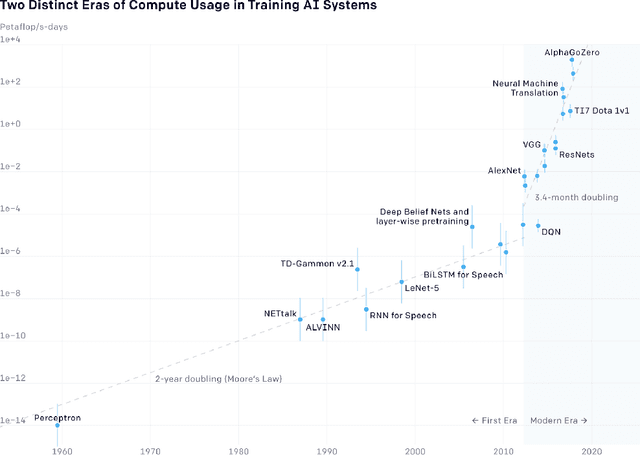
Abstract:As machine learning models are increasingly used for high-stakes decision making, scholars have sought to intervene to ensure that such models do not encode undesirable social and political values. However, little attention thus far has been given to how values influence the machine learning discipline as a whole. How do values influence what the discipline focuses on and the way it develops? If undesirable values are at play at the level of the discipline, then intervening on particular models will not suffice to address the problem. Instead, interventions at the disciplinary-level are required. This paper analyzes the discipline of machine learning through the lens of philosophy of science. We develop a conceptual framework to evaluate the process through which types of machine learning models (e.g. neural networks, support vector machines, graphical models) become predominant. The rise and fall of model-types is often framed as objective progress. However, such disciplinary shifts are more nuanced. First, we argue that the rise of a model-type is self-reinforcing--it influences the way model-types are evaluated. For example, the rise of deep learning was entangled with a greater focus on evaluations in compute-rich and data-rich environments. Second, the way model-types are evaluated encodes loaded social and political values. For example, a greater focus on evaluations in compute-rich and data-rich environments encodes values about centralization of power, privacy, and environmental concerns.
Strategic Adaptation to Classifiers: A Causal Perspective
Nov 01, 2019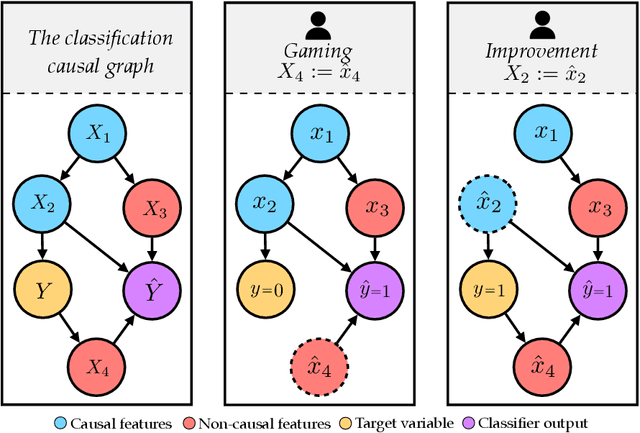

Abstract:Consequential decision-making incentivizes individuals to adapt their behavior to the specifics of the decision rule. A long line of work has therefore sought to understand and anticipate adaptation, both to prevent strategic individuals from "gaming" the decision rule and to explicitly motivate individuals to improve. In this work, we frame the problem of adaptation as performing interventions in a causal graph. With this causal perspective, we make several contributions. First, we articulate a formal distinction between gaming and improvement. Second, we formalize strategic classification in a new way that recognizes that the individual may improve, rather than only game. In this setting, we show that it is beneficial for the decision-maker to incentivize improvement. Third, we give a reduction from causal inference to designing incentivizes for improvement. This shows that designing good incentives, while desirable, is at least as hard as causal inference.
Literal or Pedagogic Human? Analyzing Human Model Misspecification in Objective Learning
Mar 09, 2019

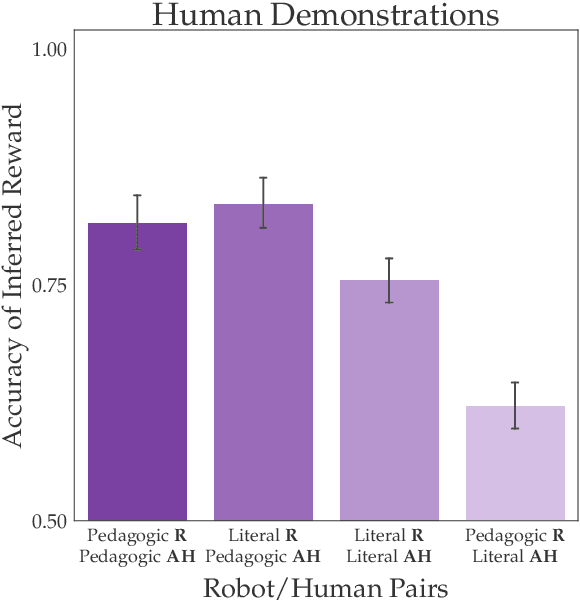
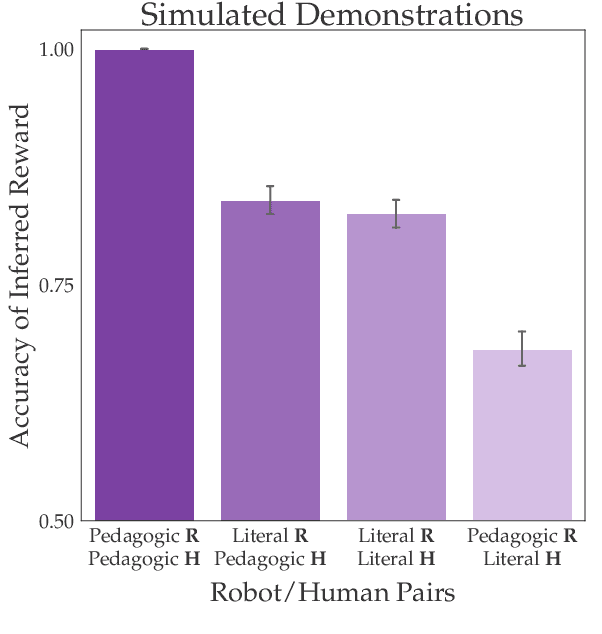
Abstract:It is incredibly easy for a system designer to misspecify the objective for an autonomous system ("robot''), thus motivating the desire to have the robot learn the objective from human behavior instead. Recent work has suggested that people have an interest in the robot performing well, and will thus behave pedagogically, choosing actions that are informative to the robot. In turn, robots benefit from interpreting the behavior by accounting for this pedagogy. In this work, we focus on misspecification: we argue that robots might not know whether people are being pedagogic or literal and that it is important to ask which assumption is safer to make. We cast objective learning into the more general form of a common-payoff game between the robot and human, and prove that in any such game literal interpretation is more robust to misspecification. Experiments with human data support our theoretical results and point to the sensitivity of the pedagogic assumption.
The Social Cost of Strategic Classification
Aug 25, 2018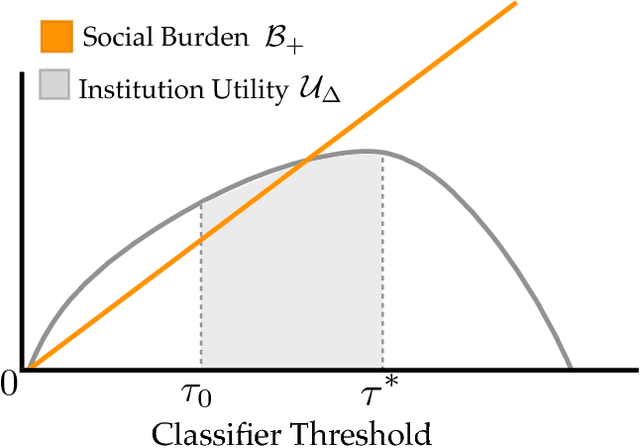
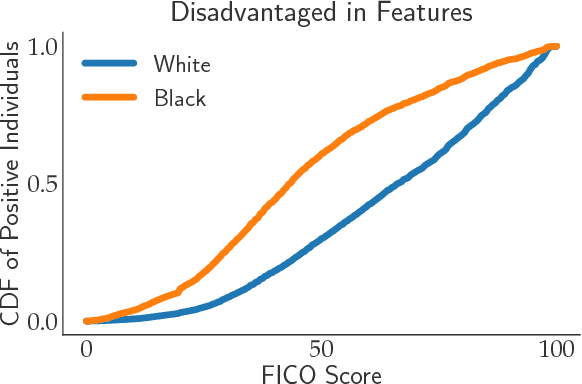
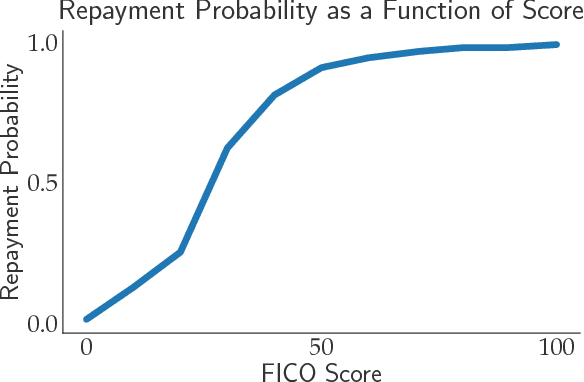
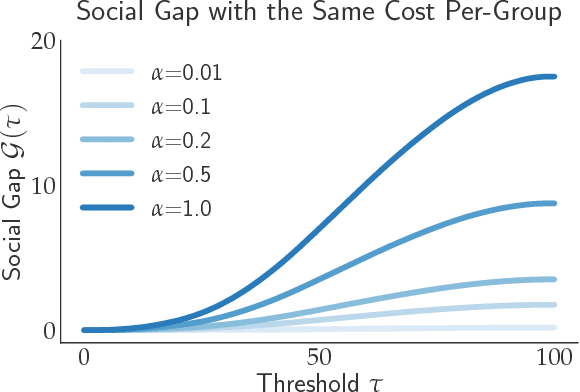
Abstract:Consequential decision-making typically incentivizes individuals to behave strategically, tailoring their behavior to the specifics of the decision rule. A long line of work has therefore sought to counteract strategic behavior by designing more conservative decision boundaries in an effort to increase robustness to the effects of strategic covariate shift. We show that these efforts benefit the institutional decision maker at the expense of the individuals being classified. Introducing a notion of social burden, we prove that any increase in institutional utility necessarily leads to a corresponding increase in social burden. Moreover, we show that the negative externalities of strategic classification can disproportionately harm disadvantaged groups in the population. Our results highlight that strategy-robustness must be weighed against considerations of social welfare and fairness.
 Add to Chrome
Add to Chrome Add to Firefox
Add to Firefox Add to Edge
Add to Edge